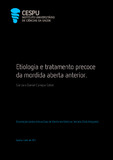Mostrar el registro sencillo del ítem
Etiologia e tratamento precoce da mordida aberta anterior
| dc.contributor.advisor | COELHO, CARLOS MANUEL LEAL MOREIRA | |
| dc.contributor.author | Coton, Gonzalo Daniel Canepa | |
| dc.date.accessioned | 2023-11-23T11:00:14Z | |
| dc.date.available | 2023-11-23T11:00:14Z | |
| dc.date.issued | 2023 | |
| dc.identifier.uri | http://hdl.handle.net/20.500.11816/4418 | |
| dc.description.abstract | O objetivo deste estudo consiste em avaliar a etiologia e os principais métodos de tratamento para as mordidas abertas anteriores (MAAs) dento-alveolares ou esqueléticas, em pacientes jovens, levando em consideração, as vantagens e as complicações envolvidas durante essas fases de tratamento para a estabilização da mordida destes pacientes durante sua fase de desenvolvimento craniofacial. A MAA pode ser definida como a presença de um trespasse vertical negativo entre os bordos incisais dos dentes anteriores superiores e inferiores, sendo muito discutida por sua origem multifatorial e por ser considerada de grande importância para os pacientes pelo fator estético. Esta causa ocorre por uma combinação variável, congénita ou adquirida. Para esta dissertação foram selecionados estudos publicados nos últimos 10 anos, nas seguintes bases de dados da área da saúde: PubMed/Medline e SciELO. Os principais resultados demonstraram que o principal objetivo do tratamento precoce da MAA é a eliminação dos hábitos bucais deletérios, fazendo uso de variados aparelhos e dispositivos que foram primariamente eficazes na diminuição da sobremordida negativa, na melhoria do posicionamento da língua e dos dentes, além de alterações fisiológicas esqueléticas. Concluiu-se que os metódos empregados para o tratamento precoce da MAA são de grande eficácia para corrigir a sobremordida e proporcionar condições fisiológicas ao sistema estomatognático, de forma a criar estabilidade a longo prazo. | pt_PT |
| dc.description.abstract | The aim of this study was to evaluate the etiology and the main treatment methods for anterior, dentoalveolar or skeletal open bites, taking into account the advantages and complications involved during these treatment phases for the stabilization of the bite of children during their craniofacial development phase. The AOB may be defined as the presence of a negative vertical overlap between the upper and lower anterior teeth’s incisal edges and is still much discussed because of its multifactor origin and because patients considered it of great importance by aesthetics factor. This cause occurs by a variable combination, congenital or acquired. The studies selected to compose the literature review published in the last 10 years in the following databases in the health area: PubMed/Medline, SciELO. The main results showed that the main objective of early treatment of AOB is the elimination of harmful oral habits, making use of various devices and devices that were primarily effective in reducing negative overbite, improving the positioning of the tongue and teeth, in addition to skeletal physiological changes. This allows us to conclude that the methods used for the early treatment of anterior open bite are very effective in increasing overbite and providing physiological functions for the stomatognathic system with long-term stability of these alterations. | pt_PT |
| dc.language.iso | por | pt_PT |
| dc.rights | info:eu-repo/semantics/openAccess | pt_PT |
| dc.subject | Anterior open bite | pt_PT |
| dc.subject | Etiology | pt_PT |
| dc.subject | Stability | pt_PT |
| dc.subject | Treatment | pt_PT |
| dc.subject | Prevalence | pt_PT |
| dc.subject | Dentoalveolar | pt_PT |
| dc.subject | Deciduous dentition | pt_PT |
| dc.subject | Mixed dentition | pt_PT |
| dc.title | Etiologia e tratamento precoce da mordida aberta anterior | pt_PT |
| dc.type | info:eu-repo/semantics/masterThesis | pt_PT |
| dc.identifier.tid | 203362365 | pt_PT |
| thesis.degree.name | Mestrado em Medicina Dentária | pt_PT |

